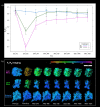Survivability of the lichen Xanthoria parietina in simulated Martian environmental conditions
- PMID: 36966209
- PMCID: PMC10039903
- DOI: 10.1038/s41598-023-32008-6
Survivability of the lichen Xanthoria parietina in simulated Martian environmental conditions
Abstract
Xanthoria parietina (L.) Th. Fr. is a widely spread foliose lichen showing high tolerance against UV-radiation thanks to parietin, a secondary lichen substance. We exposed samples of X. parietina under simulated Martian conditions for 30 days to explore its survivability. The lichen's vitality was monitored via chlorophyll a fluorescence that gives an indication for active light reaction of photosynthesis, performing in situ and after-treatment analyses. Raman spectroscopy and TEM were used to evaluate carotenoid preservation and possible variations in the photobiont's ultrastructure respectively. Significant differences in the photo-efficiency between UV irradiated samples and dark-kept samples were observed. Fluorescence values correlated with temperature and humidity day-night cycles. The photo-efficiency recovery showed that UV irradiation caused significant effects on the photosynthetic light reaction. Raman spectroscopy showed that the carotenoid signal from UV exposed samples decreased significantly after the exposure. TEM observations confirmed that UV exposed samples were the most affected by the treatment, showing chloroplastidial disorganization in photobionts' cells. Overall, X. parietina was able to survive the simulated Mars conditions, and for this reason it may be considered as a candidate for space long-term space exposure and evaluations of the parietin photodegradability.
© 2023. The Author(s).
Conflict of interest statement
The authors declare no competing interests.
Figures







References
-
- Horneck G, Walter N, Westall F, Grenfell JL, Martin WF, Gomez F, Leuko S, Lee N, Onofri S, Tsiganis K, Saladino R, Pilat-Lohinger E, Palomba E, Harrison J, Rull F, Muller C, Strazzulla G, Brucato JR, Rettberg P, Capria MT. AstRoMap European astrobiology roadmap. Astrobiology. 2016;16(3):201–243. doi: 10.1089/ast.2015.1441. - DOI - PMC - PubMed
-
- de la Torre Noetzel R, Ortega Garcia MV, Miller AZ, Bassy O, Granja C, Cubero B, Jordão L, Martínez Frías J, Rabbow E, Backhaus T, Ott S, Sancho LG, de Vera JPP. Lichen vitality after a space flight on board the EXPOSE-R2 facility outside the international space station: Results of the biology and mars experiment. Astrobiology. 2020;20(5):583–600. doi: 10.1089/ast.2018.1959. - DOI - PubMed
Publication types
MeSH terms
Substances
Supplementary concepts
LinkOut - more resources
Full Text Sources
Miscellaneous

